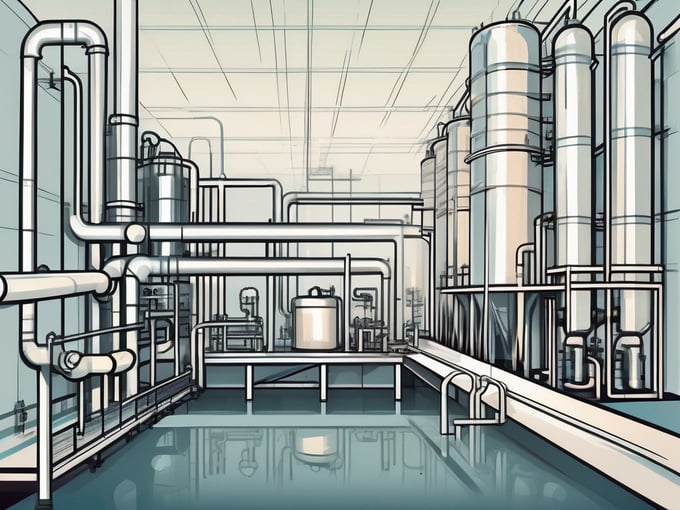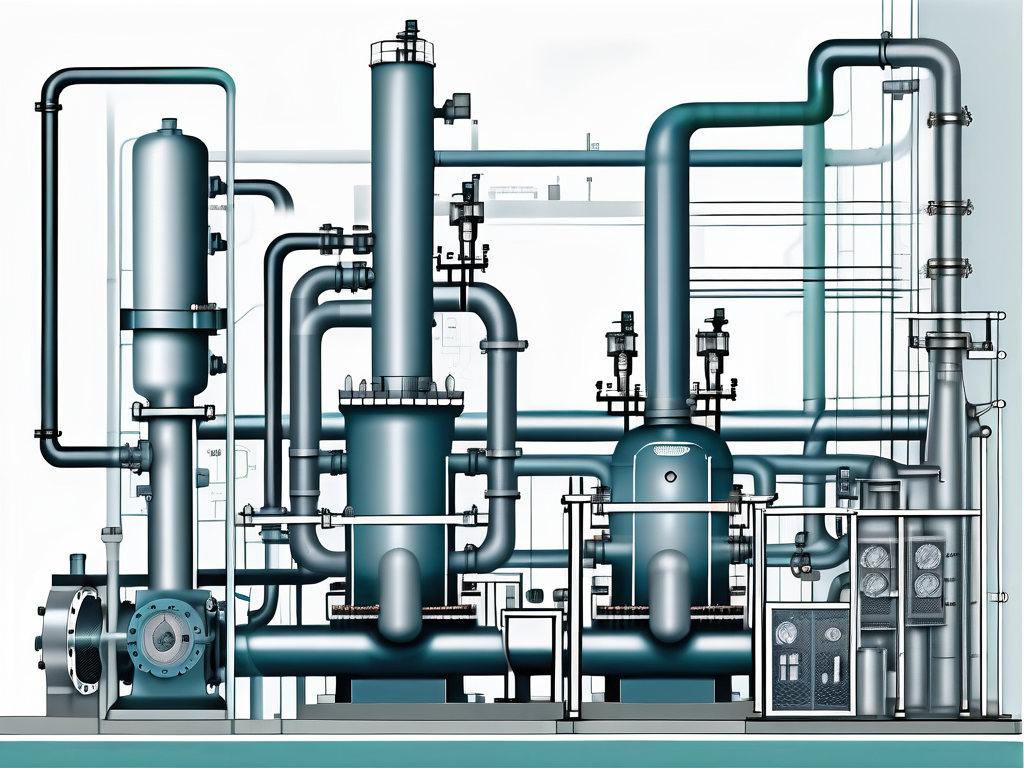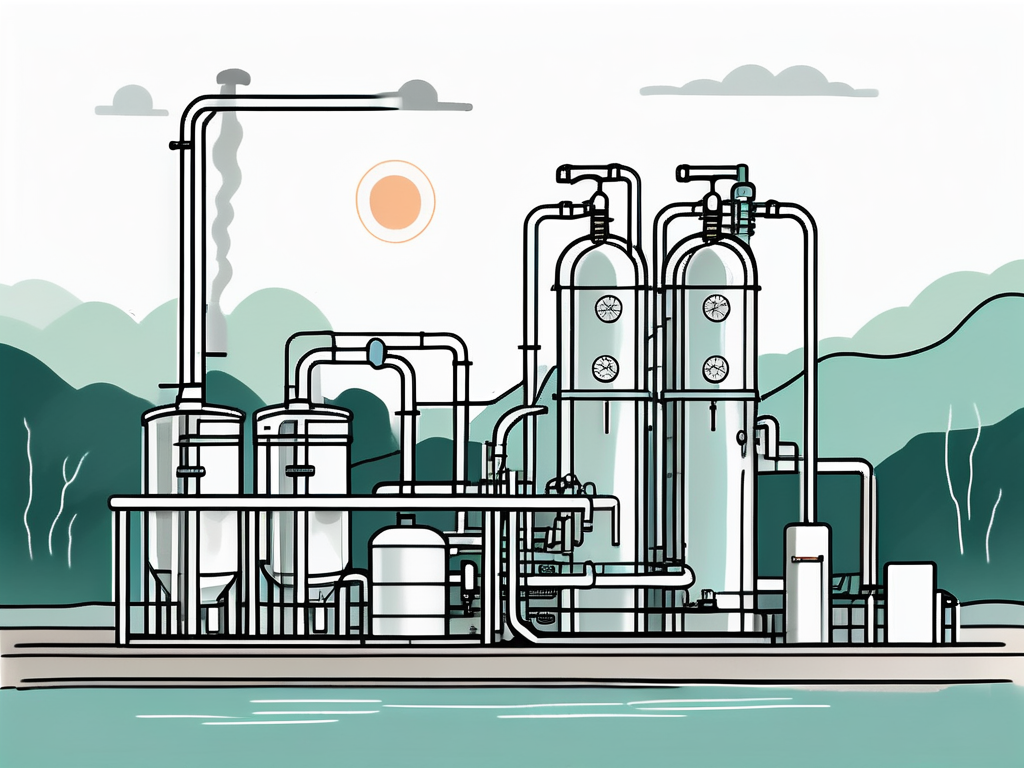
Influent Pumping Station: Wastewater Treatment Explained
In the field of wastewater treatment, the influent pumping station plays a crucial role. It is the first point of contact for wastewater entering a treatment plant, and its function is to pump the wastewater from a lower level to a higher level, enabling the subsequent treatment processes to take place. This article will delve into the intricacies of the influent pumping station, its components, functions, and its role in the larger context of wastewater treatment.
Understanding the influent pumping station is essential for anyone involved in the wastewater treatment industry. Whether you're an engineer designing a new treatment plant, a plant operator ensuring the smooth running of the treatment processes, or a student studying environmental engineering, this glossary entry will provide you with a comprehensive understanding of the influent pumping station.
Components of an Influent Pumping Station
The influent pumping station is made up of several key components, each playing a vital role in the overall functioning of the station. These components include the wet well, the pumps, the motor, the control panel, and the backup power supply. Each of these components will be discussed in detail in the following sections.

It's important to note that while the basic components of an influent pumping station are generally the same, the specific design and configuration can vary greatly depending on the size of the treatment plant, the volume of wastewater being treated, and the specific requirements of the treatment process.
Wet Well
The wet well is the initial collection point for the incoming wastewater. It is typically a large, underground concrete tank where the wastewater is temporarily stored before being pumped to the next stage of treatment. The wet well is designed to be large enough to handle the maximum flow of wastewater expected at the treatment plant.
The design of the wet well is crucial to the efficient operation of the influent pumping station. If the wet well is too small, it can lead to frequent pump cycling, which can wear out the pumps prematurely. If the wet well is too large, it can result in the wastewater spending too much time in the well, leading to the growth of anaerobic bacteria and the production of unpleasant odors.
Pumps
The pumps are the heart of the influent pumping station. They are responsible for moving the wastewater from the wet well to the next stage of the treatment process. The pumps used in an influent pumping station are typically submersible centrifugal pumps, which are designed to handle the high volumes of wastewater and the presence of solid materials in the wastewater.
The number and capacity of the pumps used in an influent pumping station depend on the volume of wastewater to be handled and the height to which the wastewater needs to be pumped. In most cases, multiple pumps are used to provide redundancy and ensure the continuous operation of the station even if one pump fails.
Functions of an Influent Pumping Station
The primary function of an influent pumping station is to pump the incoming wastewater from a lower level to a higher level. This is necessary because most wastewater treatment processes rely on gravity to move the wastewater through the various stages of treatment. By pumping the wastewater to a higher level at the start of the process, the need for additional pumping later in the process is minimized.
However, the influent pumping station also performs several other important functions. These include screening the incoming wastewater to remove large objects, measuring the flow of wastewater to control the operation of the pumps, and providing a means of bypassing the treatment plant in case of a plant shutdown or maintenance.
Screening
Screening is the first step in the treatment of wastewater and is performed at the influent pumping station. The purpose of screening is to remove large objects from the wastewater that could damage the pumps or other equipment in the treatment plant. These objects can include rags, plastic bags, sticks, and other debris.
The screening process typically involves a bar screen, which is a series of parallel bars spaced a certain distance apart. The wastewater flows through the bars, and any objects larger than the spacing between the bars are trapped and removed. The screened wastewater then flows into the wet well for pumping.
Flow Measurement
Flow measurement is another important function of the influent pumping station. By measuring the flow of wastewater entering the station, the operation of the pumps can be controlled to match the incoming flow. This helps to prevent the overloading of the treatment plant and ensures the efficient use of energy.
Flow measurement is typically performed using a flow meter, which can be either a mechanical device such as a weir or a flume, or an electronic device such as an ultrasonic flow meter. The data from the flow meter is used to control the operation of the pumps, either manually by the plant operator or automatically by a control system.
Role in Wastewater Treatment
The influent pumping station plays a crucial role in the overall wastewater treatment process. As the first point of contact for the incoming wastewater, it sets the stage for the subsequent treatment processes. The efficient operation of the influent pumping station is therefore essential for the overall efficiency of the treatment plant.
By pumping the wastewater to a higher level, the influent pumping station enables the use of gravity to move the wastewater through the various stages of treatment. This not only simplifies the design of the treatment plant but also reduces the energy consumption of the plant. The screening and flow measurement functions of the station also contribute to the efficient operation of the plant by preventing damage to the equipment and ensuring the optimal use of resources.
Pre-treatment
The influent pumping station is also involved in the pre-treatment of the wastewater. As mentioned earlier, the screening process performed at the station removes large objects from the wastewater that could damage the equipment in the treatment plant. This is an important step in the pre-treatment of the wastewater and helps to ensure the smooth operation of the subsequent treatment processes.
In addition to screening, some influent pumping stations also include a grit removal system. Grit is a term used to describe small, abrasive particles such as sand and gravel that can be present in the wastewater. These particles can cause wear and tear on the pumps and other equipment in the treatment plant, so removing them at the influent pumping station can help to extend the life of the equipment.
Flow Equalization
Another important role of the influent pumping station in wastewater treatment is flow equalization. The flow of wastewater entering a treatment plant can vary greatly throughout the day, with peak flows occurring in the morning and evening. These fluctuations can be difficult for the treatment plant to handle and can lead to the overloading of the plant during peak flows and underutilization during low flows.
Flow equalization involves temporarily storing the incoming wastewater during peak flows and then releasing it during low flows. This helps to smooth out the flow of wastewater entering the treatment plant, making it easier for the plant to handle. The wet well of the influent pumping station can be used for this purpose, providing a simple and cost-effective solution for flow equalization.
Design Considerations
The design of an influent pumping station is a complex task that requires careful consideration of a number of factors. These factors include the volume and characteristics of the wastewater, the height to which the wastewater needs to be pumped, the availability of power, the need for redundancy, and the requirements of the local regulatory authorities.
The design process typically involves a team of engineers and specialists who work together to develop a design that meets the specific needs of the treatment plant. The following sections will discuss some of the key considerations in the design of an influent pumping station.
Volume and Characteristics of Wastewater
The volume and characteristics of the wastewater are perhaps the most important factors to consider in the design of an influent pumping station. The volume of wastewater determines the size of the wet well and the capacity of the pumps, while the characteristics of the wastewater, such as its temperature, pH, and the presence of solid materials, can affect the choice of materials and equipment.
For example, if the wastewater contains a high amount of solid materials, the pumps need to be designed to handle these materials without clogging or damage. Similarly, if the wastewater is highly corrosive, the materials used in the construction of the station need to be resistant to corrosion. These factors need to be carefully considered in the design of the station to ensure its efficient and reliable operation.
Height to be Pumped
The height to which the wastewater needs to be pumped is another important factor in the design of an influent pumping station. This height, known as the total dynamic head, determines the pressure that the pumps need to generate to move the wastewater to the next stage of treatment.
The total dynamic head is calculated by adding the static head, which is the vertical distance from the surface of the wastewater in the wet well to the highest point in the pumping system, and the friction head, which is the pressure loss due to the friction of the wastewater flowing through the pipes and fittings. The pumps need to be selected to provide the required pressure at the expected flow rate of the wastewater.
Maintenance and Troubleshooting
Like any mechanical system, an influent pumping station requires regular maintenance to ensure its efficient and reliable operation. This maintenance includes the inspection and cleaning of the wet well, the servicing of the pumps, the testing of the control system, and the checking of the backup power supply.
In addition to regular maintenance, the operators of the influent pumping station also need to be prepared to troubleshoot any problems that may arise. This can include issues such as pump failures, blockages in the wet well, malfunctions of the control system, and power outages. The following sections will discuss some of the common maintenance and troubleshooting tasks for an influent pumping station.
Pump Maintenance
The pumps are the most critical component of an influent pumping station, and their maintenance is therefore of utmost importance. Pump maintenance typically involves checking the condition of the pump seals, inspecting the impeller for wear or damage, and testing the motor for proper operation.
In addition to these routine checks, the pumps also need to be serviced on a regular basis. This service can include the replacement of worn or damaged parts, the lubrication of moving parts, and the adjustment of the pump settings. Regular pump maintenance not only ensures the efficient operation of the pumps but also extends their lifespan and reduces the risk of unexpected failures.
Control System Troubleshooting
The control system of an influent pumping station is responsible for the automatic operation of the pumps based on the level of wastewater in the wet well. If the control system malfunctions, the pumps may not operate correctly, leading to problems such as overflows or dry running.
Troubleshooting the control system typically involves checking the operation of the level sensors, testing the control panel for proper function, and inspecting the wiring for any signs of damage or corrosion. If a problem is found, the faulty component can be repaired or replaced to restore the proper operation of the control system.
Conclusion
The influent pumping station is a critical component of any wastewater treatment plant. It performs several important functions, including pumping the wastewater to a higher level for subsequent treatment, screening the wastewater to remove large objects, measuring the flow of wastewater to control the operation of the pumps, and providing a means of bypassing the treatment plant in case of a plant shutdown or maintenance.

The design, operation, and maintenance of an influent pumping station require a thorough understanding of the principles of fluid mechanics, the characteristics of the wastewater, and the requirements of the treatment process. This glossary entry has provided a comprehensive overview of these aspects, and it is hoped that it will be a valuable resource for anyone involved in the wastewater treatment industry.



